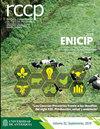蠕变饲料和日粮复杂性对哺乳仔猪生长性能的影响
IF 0.5
4区 农林科学
Q4 AGRICULTURE, DAIRY & ANIMAL SCIENCE
引用次数: 1
摘要
背景:爬行饲料是为哺乳仔猪提供的固体饲料,并在泌乳后期提供额外的营养。然而,蠕变进给的效果是不一致的;关于爬行日粮复杂性对仔猪生产性能的影响,目前还知之甚少。目的:通过两个试验,评价爬行饲料及其复杂性对断奶仔猪生长性能的影响。方法:在实验1中,将8窝仔猪(平均19.9±1.1日龄;初始体重:6.74±1.2 kg)分为两个日粮处理,分别考虑品种、窝大小和体重:无爬行饲料(n=3)和爬行饲料(n=5;断奶前提供8天)。断奶时(28日龄),将猪分为三个处理组(6头猪/圈,3个重复;初始体重:9.66±0.34kg),按性别、体重和品种进行平衡,如下:爬行饲料-进食者、爬行饲料-非进食者和无爬行饲料。在实验2中,从12日龄(平均12.0±1.3日龄)到断奶(25日龄),对7窝哺乳仔猪(仔猪初始体重:3.79±0.55kg)提供了两种不同类型的爬行饲料。治疗方法为:HCF(n=4):高度复杂的爬行饮食,含3%鱼粉、2.4%血粉和15%乳清;2)LCF(n=3):不含上述成分的低复杂爬行日粮。断奶时,仅食用猪被分为2个处理(6头猪/圈,3个重复;初始体重:7.53±0.97 kg),按性别、品种和体重平衡,如下:HCF食用者和LCF食用者。在两个实验中,将爬行饲料与1%Cr2O3混合,以测量进食者/非进食者分类的粪便颜色,并将猪以普通育婴日粮喂养21天。结果:在两个试验中,不同处理的仔猪断奶体重和育婴室整体生长性能没有差异。在实验2中,HCF和LCF处理之间的爬行采食量和每窝进食者的百分比没有差异,而在断奶后的第7-14天,HCF进食者的平均日增重(p=0.08)和增重饲料比(p=0.09)往往高于LCF进食者。结论:爬行饲料在哺乳期和育婴期不会影响仔猪的整体生长,但其复杂性可能会影响仔猪早期育婴期的生长。本文章由计算机程序翻译,如有差异,请以英文原文为准。
The effect of creep feed and diet complexity on growth performance in suckling and weaned pigs
Background: Creep feed is offered to suckling piglets to introduce solid feed and provide extra nutrients in late lactation. However, the effect of creep feed is inconsistent; there is little information about the effect of creep diet complexity on piglet performance. Objective: Two experiments were conducted to evaluate the effect of creep feed and its complexity on growth performance of suckling and weaned pigs. Methods: In Exp. 1, eight litters (average 19.9 ± 1.1 d of age; initial piglet weight: 6.74 ± 1.2 kg) were allotted to two dietary treatments considering breed, litter size and weight, as follows: no creep feed (n=3) and creep feed (n=5; offered for 8 days before weaning). At weaning (d 28 of age), the pigs were divided into three treatments (6 pigs/pen, 3 replicates; initial body weight: 9.66 ± 0.34 kg) balanced by gender, body weight, and breed, as follows: creep feed eaters, creep feed non-eaters, and no creep feed. In Exp. 2, two different types of creep feed were offered to suckling piglets (initial piglet weight: 3.79 ± 0.55 kg) in seven litters from d 12 of age (average 12.0 ± 1.3 d of age) to weaning (d 25 of age). Treatments were: HCF (n=4): highly-complex creep diet containing 3% fish meal, 2.4% blood meal, and 15% whey; and 2) LCF (n=3): lowly-complex creep diet without the mentioned ingredients. At weaning, only eater pigs were divided into 2 treatments (6 pigs/pen, 3 replicates; initial body weight: 7.53 ± 0.97 kg) balanced by gender, breed and body weight as follows: HCF eaters and LCF eaters. In both experiments, creep feed was mixed with 1% Cr2O3 to measure fecal color for eater/non-eater categorization and the pigs were fed a common nursery diet for 21 days. Results: In both experiments, there were no differences on piglet weaning weight and overall nursery growth performance among the treatments. In Exp. 2, the creep feed intake and percentage of eaters per litter were not different between the HCF and LCF treatments, whereas the HCF eaters tended to have a greater average daily gain (p=0.08) and gain to feed ratio (p=0.09) than the LCF eaters during d 7-14 postweaning. Conclusion: Creep feed did not affect overall piglet growth in suckling and nursery phases, but its complexity might affect pig growth in the early nursery phase.
求助全文
通过发布文献求助,成功后即可免费获取论文全文。
去求助
来源期刊

Revista Colombiana De Ciencias Pecuarias
AGRICULTURE, DAIRY & ANIMAL SCIENCE-
CiteScore
0.80
自引率
0.00%
发文量
18
审稿时长
6-12 weeks
期刊介绍:
The editors of Revista Colombiana de Ciencias Pecuarias (RCCP) welcome the submission of original manuscripts on experimental and clinical studies associated with the broad areas of animal sciences and veterinary medicine as they interface with biochemistry, molecular biology, physiology, pharmacology, toxicology, pathology, microbiology, parasitology, immunology and epidemiology. The scope of the journal includes studies of basic and applied research in animal management and production, feeding and nutrition, reproduction, breeding, genetics, animal welfare and behavior; as well as animal production focussed from biotechnology, soil science, agrostology, silvopastoral systems, livestock economics and the environment.
The criteria for acceptance of papers submitted for publication are originality, quality and clarity of the content. Each contribution must be based on original, unpublished research that has not been simultaneously submitted to other journals. All papers will be peer reviewed. All authors bear responsibility for ensuring the integrity and quality of their reported research. It is the author''s responsibility to secure permission to use figures or tables that have been published elsewhere.
Contributions may be classified as original research, review, rapid communication, clinical case studies or methodological articles, as well as news/commentaries or letters to the editor. Most review articles are invited by the editor. Authors interested in submitting a review article should contact the corresponding editor. Rapid publication of original manuscripts is a goal of the journal. Manuscripts must be written in English. Each manuscript is considered for publication with the understanding that it has not been simultaneously submitted to any other journal. Upon acceptance for publication, papers are subject to editorial review and revision.
 求助内容:
求助内容: 应助结果提醒方式:
应助结果提醒方式:


